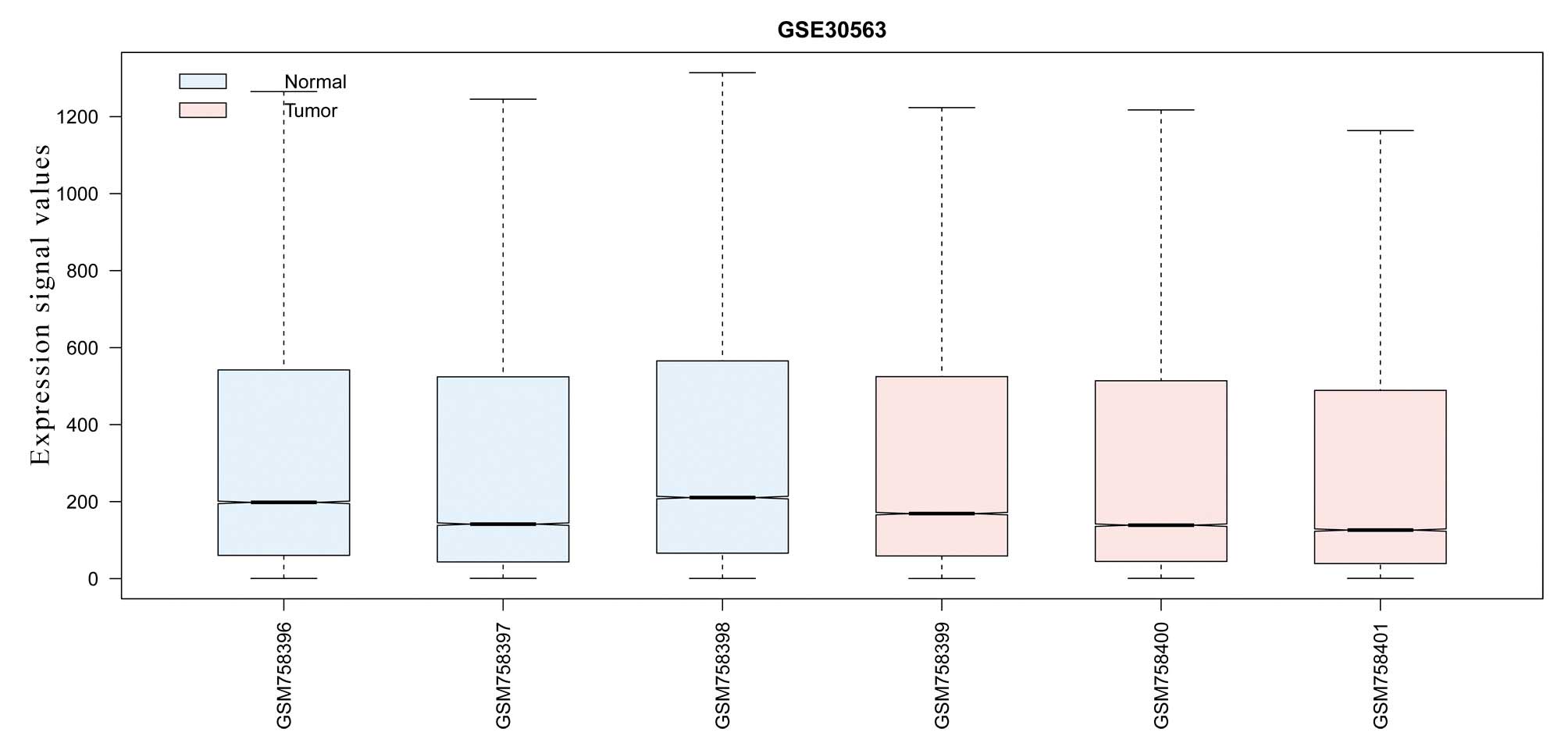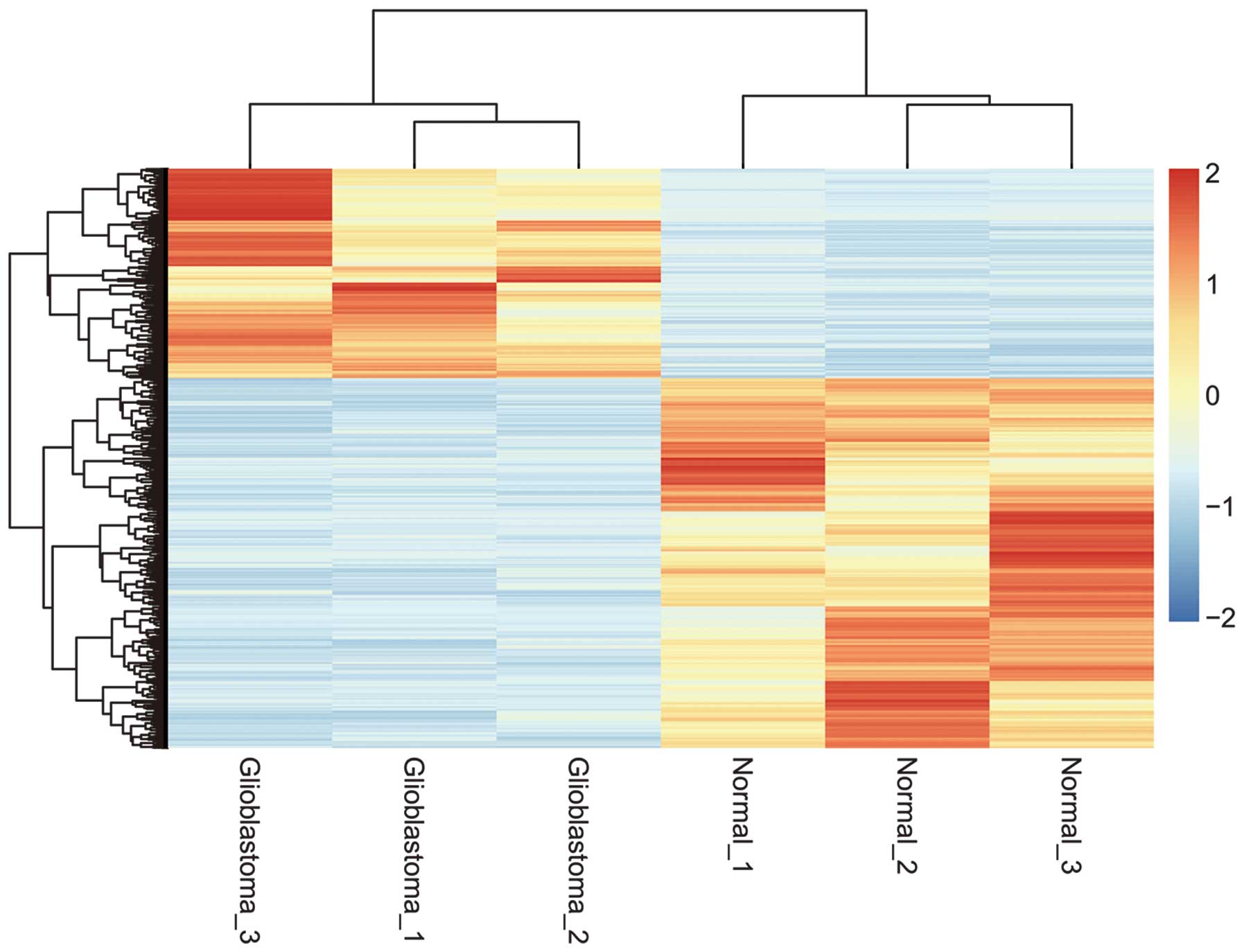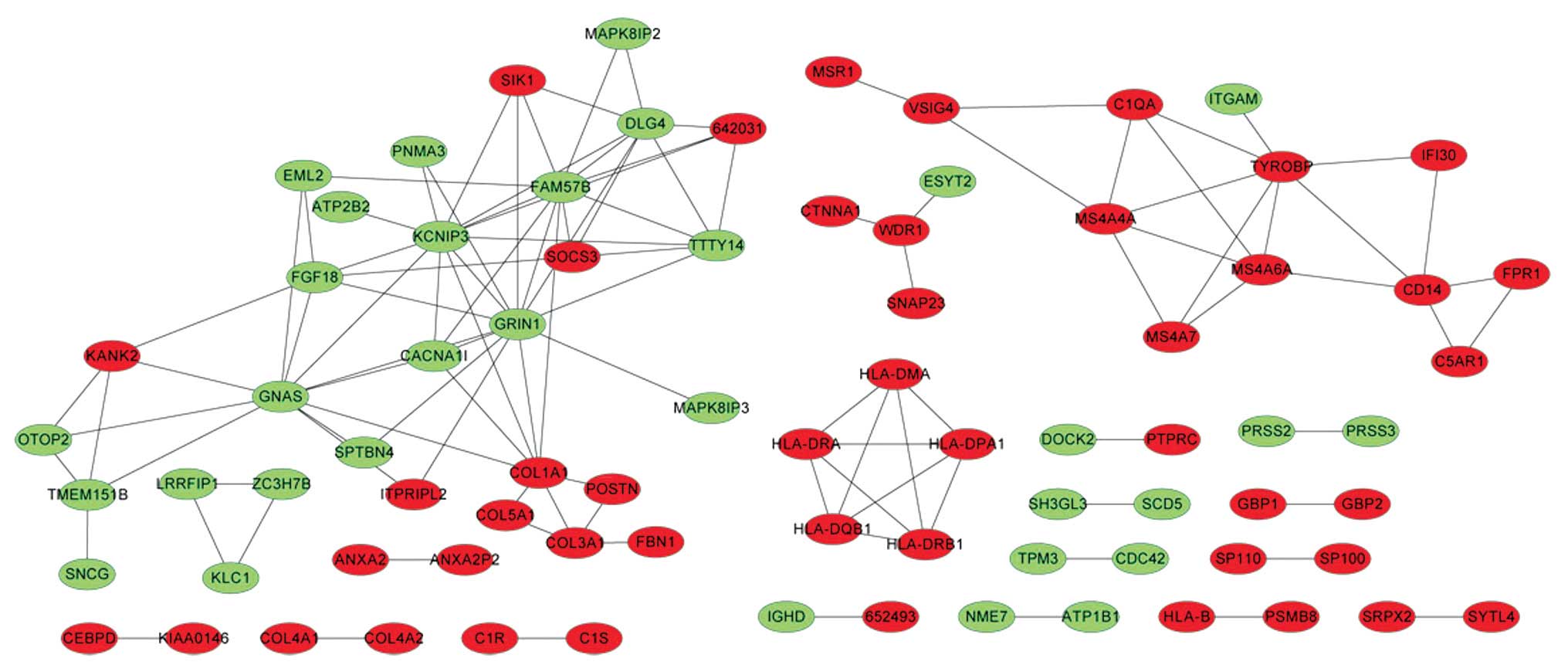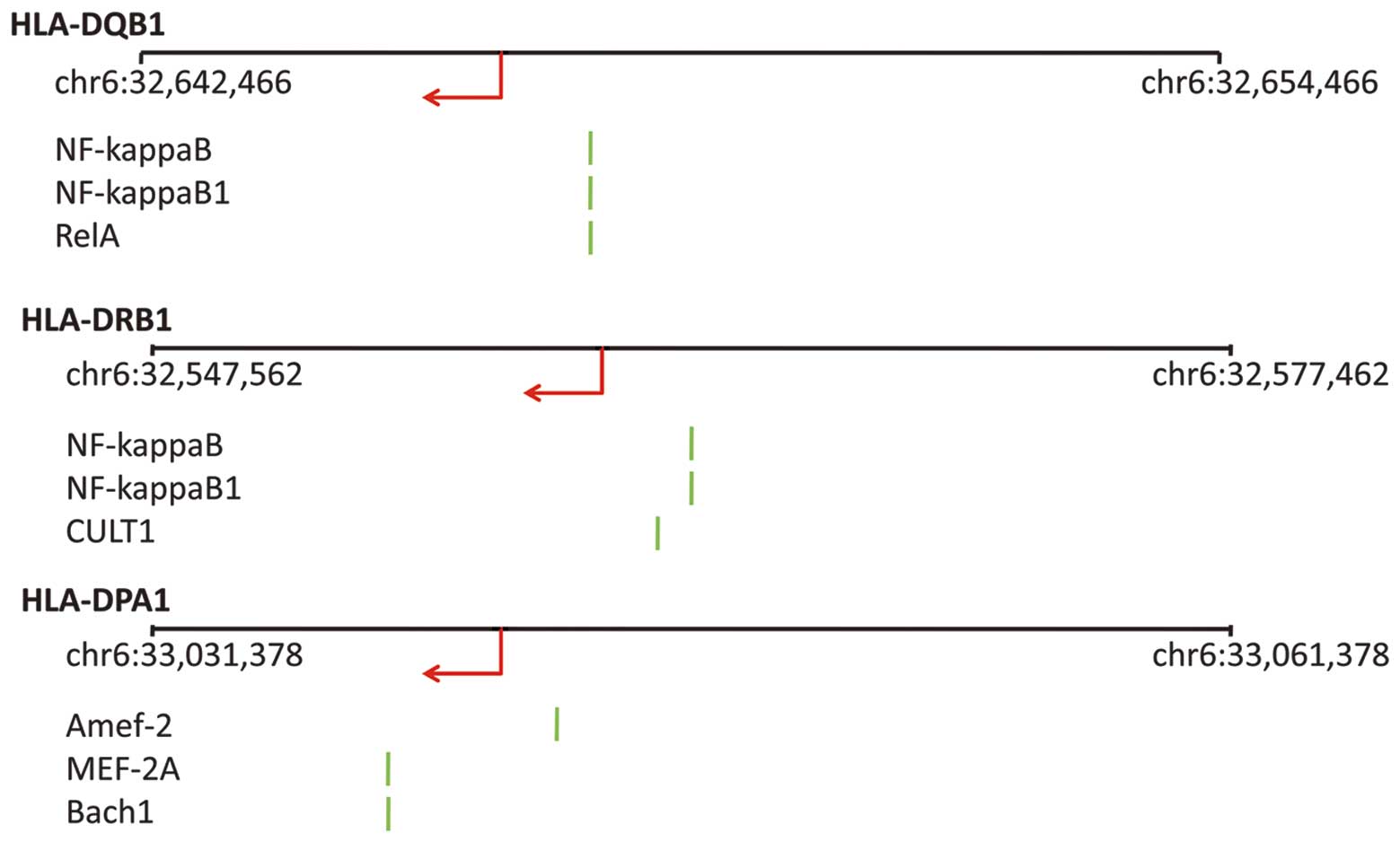Screening of differentially expressed genes associated with human glioblastoma and functional analysis using a DNA microarray
- Authors:
- Published online on: April 22, 2015 https://doi.org/10.3892/mmr.2015.3659
- Pages: 1991-1996
Abstract
Introduction
Glioblastoma multiforme (GBM) is the most malignant type of human glioma and has a poor prognosis. Despite advances in diagnosis and treatment, the median survival rate of patients with GBM remains ~15 months (1–3). GBM is one of the most intractable types of refractory tumor. Surgery and radiotherapy have been the predominant forms of therapy for GBM, however, the curative effect is poor (4). Gene treatment offers possible approaches in the treatment of GBM, however, it retains shortcomings, including the lack of special target genes and high-efficiency carriers (5). For decades, how to treat GBM has remained a focus and difficulty in investigations and clinical treatment.
There has been substantial progress in the use of microarrays for investigating the molecular mechanisms of brain gliomas. Microarrays are valuable for identifying the important genes involved in the occurrence, development and targeted therapy of gliomas (6). Microarrays have been used to screen genes associated with GBM (3,7,8), and bioinformatics analysis has revealed that these genes, screened using a microarray, are closely associated with cell signal transduction, cell metabolization, cytoskeleton and motility, immunity, the cell cycle and apoptosis (7). However, the specific molecular mechanisms underlying human GBM are not yet fully understood.
In the present study, the transcriptional profile of GSE30563 was downloaded and the differentially expressed genes (DEGs) between GBM and healthy brain tissues were identified. In addition, a co-expression network of DEGs was constructed, and Gene Ontology (GO) functional and Kyoto Encyclopedia of Genes and Genomes (KEGG) pathway analyses were performed to identify the target genes for the diagnosis and treatment of GBM. Finally, the interactions between DEGs and transcription factors were assessed for further evaluation at the molecular level. The findings of these investigations may contribute to improvements in the understanding and diagnosis of GBM, and the design of target-specific drugs.
Materials and methods
Microarray data
The transcriptional profile of GSE30563 was downloaded from Gene Expression Omnibus (GEO) (http://www.ncbi.nlm.nih.gov/geo/), which was based on the platform of the Affymetrix Human Genome U133 Plus 2.0 array. This dataset (http://www.ncbi.nlm.nih.gov/geo/query/acc.cgi?acc=GSE30563) was deposited by Lee et al (Ajou University School of Medicine, Suwon, South Korea). To identify DEGs, human brain tumor samples and normal brain samples were collected from patients with a brain tumor, for subsequent RNA extraction and hybridization on Affymetrix microarrays. A total of six genechips (GSM758396, GSM758397, GSM758398, GSM758399, GSM758400 and GSM758401) were available for further analysis, including three genechips of brain tumor samples and three genechips of normal brain samples.
Data pre-processing and analysis of differential expression
The probe-level data in the raw data files were converted into expression measures, according to the function of log2 (9). The expression values of all the probes were matched to the genes and the empty probes were reduced. The LIMMA package in R (http://www.bioconductor.org/packages/release/bioc/html/limma.html) (10) was used to identify the DEGs in the brain tumor samples compared with the healthy controls. The present study selected a cut-off criteria of P≤0.01 and |log2fold change|>1 to identify the DEGs.
Comparison of differential expression in different samples
The expression values of the DEGs in each sample were extracted from the expression value files, according to the information of the probes corresponding to the DEGs. Based on these expression values, the pheatmap package in R was used for hierarchical clustering (11), through Euclidean distance (12), and a heat map was constructed.
Searching for the co-expression network of DEGs
COXPRESdb (http://coxpresdb.hgc.jp) is a database of co-expressed gene networks and can assist in elucidating the function and regulation network of genes in a wide range of mammals (13). Based on the hypothesis that genes, which are regulated by the same transcription factor, are co-expressed, and that co-expressed genes may be associated in function (14), the DEGs were divided into either upregulated or downregulated genes, and co-expression networks of the DEGs were constructed, using the information obtained from COXPRESdb. The gene pairs with a co-expression coefficient >0.6 were selected, and the network was visualized using Cytoscape software (http://www.cytoscape.org/) (15).
GO and pathway analyses of the DEGs
The Database for Annotation, Visualization and Integrated Discovery (DAVID) is a web-accessible program, which clusters distinct genes by the pathways in which they are involved, producing intuitive graphical summaries (16). The DEGs in the co-expression networks in the present study were analyzed using DAVID to identify which biological process the genes in the networks were involved in. To circumvent the problem of multi-testing, which may induce too many false positive results, the Benjamini and Hochberg method (17) was used to adjust the raw P-values into false discovery rate (FDR). FDR<0.05 was used as the cut-off criterion. The DEGs were analyzed using KEGG, and the biological pathways, which were mapped significantly by the DEGs were identified (18,19).
Interactions between DEGs and transcription factors
The gene sequence can inhibit or enhance the expression of a gene by covalently binding to the transcription factor DNA binding domain (20). In the present study, based on text mining using PubChem Bioassay neighboring analysis (http://pubchem.ncbi.nlm.nih.gov/) (21), the interactions between the genes and transcription factors were extracted using the online tool, EpiTect ChIP qPCR Primers (http://www.sabiosciences.com/chipqpcrsearch.php?app=TFBS).
Results
Screening for DEGs
Following data preprocessing, the expression values with high standardization were analyzed through comparison of the differences (Fig. 1). A total of 1,006 DEGs, exhibiting a cut-off criteria P<0.01 and |logFC|>1, were selected, including 638 downregulated and 368 upregu-lated DEGs.
Hierarchical clustering analysis of DEGs
Hierarchical clustering revealed systematic variations in the expression levels of genes between the brain tumor samples and the healthy control samples (Fig. 2). The results revealed that these differential probes were able to distinguish these two groups from the whole samples.
Searching for the co-expression networks of DEGs
COXPRESdb was used to construct a co-expression network of the resulting DEGs, following which a total of 113 gene pairs with a co-expressed coefficient >0.6 were identified. These were subsequently visualized using Cytoscape (Fig. 3) and, among them, the ANXA2 and ANXA2P2 gene pairs were selected as exhibiting the highest co-expression coefficient of 0.94.
GO functional and pathway analyses of the DEGs
Based on the co-expression network, GO functional enrichment analysis of the DEGs was performed using DAVID software, with FDR<0.05. The results indicated that 59 DEGs were significantly increased in seven GO terms (Table I). The most significant functional term was associated with the immune response, and the genes enriched in this term included major histocompatibility complex (MHC) class II, DQβ1 (HLA-DQB1), MHC class II, DRβ1 (HLA-DRB1), MHC class IB (HLA-B), MHC class II, DMα (HLA-DMA), MHC class II, DPα1 (HLA-DPA1) and MHC class II, DRα (HLA-DRA). The KEGG pathway analysis identified six pathways (Table II), which had an FDR<0.05. The most significant pathway was associated with allograft rejection, and the genes enriched in this pathway were HLA-DQB1, HLA-DRB1, HLA-DPA1, HLA-B, HLA-DMA and HLA-DRA.
Transcription factors of important DEGs
Based on the comparison of the most significant biological process and KEGG pathway, six genes, including HLA-DQB1, HLA-DRB1, HLA-DPA1, HLA-B, HLA-DMA and HLA-DRA, were differentially expressed in two lists at the same time, located on the short arm of chromosome 6 (Fig. 4). A total of 17 transcription factors, including nuclear factor (NF)-κB, NF-κB1 and their binding sites, were identified with these six important DEGs.
Discussion
GBM is one of the most frequent types of human brain cancer and it develops from either a lower grade astrocytic tumor or primary GBM (22). However, neither chemotherapy nor radiotherapy have been effective in treating this type of cancer (23). Biochip technology has emerged as an efficient, rapid and multi-parameter technology, which provides a useful strategy for diagnosis, classification and therapy against the development of human GBM.
The present study identified 1,006 DEGs, including 638 upregulated and 368 downregulated DEGs, from the gene expression profile of GSE30563. Following this, a co-expression network of DEGs was constructed and GO functional and KEGG pathway analyses were performed. Functional analysis of the DEGs demonstrated a close correlation with the immune response. Additionally, allograft rejection was the most significantly enriched pathway, and the genes involved in these processes were HLA-DQB1, HLA-DRB1, HLA-DPA1, HLA-B, HLA-DMA and HLA-DRA.
These genes belong to the human leukocyte antigen (HLA) gene family. The HLA genes encode numerous molecules, including HLA class I and II, and are known to be associated with the majority of autoimmune diseases (24). Human HLA molecules are important in eliminating tumor cells with cellular and humoral immunity (25,26). The HLA-DRA, HLA-DRB1, HLA-DQB1, HLA-DPA1 genes belong to the HLA class II β chain paralogs. They bind peptides derived from antigens, which access the endocytic route of antigen presenting cells (APCs) and present them on the cell surface for recognition by CD4 T-cells (27). The HLA-DMA gene belongs to the HLA class II α chain paralogues. It is involved in the peptide loading of MHC class II molecules, by assisting in the release of the class II-associated invariant chain peptide molecule from the peptide binding site (28). The HLA-B gene belongs to the HLA class I heavy chain paralogues. Class I molecules are important in the immune system by presenting peptides derived from the endoplasmic reticulum lumen (29). GBM function profoundly impairs the immune response by inhibiting the proliferation and activation of T-cells, inducing regulator T-cells and triggering apoptosis (30). In addition, it has been reported that the expression of HLA is positively associated with patients with GBM. For example, compared with the control population, HLA-B*27 exhibits a 2.7-fold increase and HLA-DRB1*15 exhibits a 2.2-fold increase in the risk of glioma occurrence (31), suggesting that the HLA family may be used as a specific therapeutic molecular target in the treatment of GBM.
Allograft rejection includes a coordinated response of the innate and adaptive immune systems of the host (32). The mechanism for allograft rejection in the immune response may be similar to this (33), in that the innate immune system is involved in the early phase of the allograft response by chemokines and cell adhesion, which are essential for leukocyte migration into the graft and T-cell trafficking between lymph nodes and the transplant. The T cells and other cells from the innate immune system act synergistically to reject the allograft through nonexclusive pathways, including the cytotoxicity of contact-dependent T cells, the activation of granulocyte and natural killer cells and the production of alloantibody. GBM is closely associated with the immune response, suggesting that allograft rejection is possibly involved in the processes of GBM. However, further investigations are required to confirm this hypothesis.
In conclusion, the present study demonstrated that HLA-DQB1, HLA-DRB1, HLA-DPA1, HLA-B, HLA-DMA, HLA-DRA are associated with GBM. In addition, the pathogenesis of GBM was closely associated with the immune response and pathways, including allograft rejection. These findings may offer novel targets for the diagnosis and treatment of GBM.
Acknowledgments
The authors would like to thank to all the authors who contributed to this study.
References
|
Buckner JC: Factors influencing survival in high-grade gliomas. Seminars in oncology. Elsevier; pp. 10–14. 2003, View Article : Google Scholar | |
|
Dubrow R, Darefsky AS, Jacobs DI, et al: Time trends in glioblastoma multiforme survival: the role of temozolomide. Neuro Oncol. 15:1750–1761. 2013. View Article : Google Scholar : PubMed/NCBI | |
|
Liu Z, Niu Y, Xie M, Bu Y, Yao Z and Gao C: Gene expression profiling analysis reveals that DLG3 is down-regulated in glioblastoma. J Neurooncol. 116:465–476. 2014. View Article : Google Scholar : PubMed/NCBI | |
|
Saggioro FP, Neder L, Stávale JN, et al: Fas, FasL and cleaved caspases 8 and 3 in glioblastomas: a tissue microarray-based study. Pathol Res Pract. 210:267–273. 2014. View Article : Google Scholar : PubMed/NCBI | |
|
Aghi M and Chiocca EA: Gene therapy for glioblastoma. Neurosurg Focus. 20:E18. 2006.PubMed/NCBI | |
|
Mischel PS, Cloughesy TF and Nelson SF: DNA-microarray analysis of brain cancer: molecular classification for therapy. Nat Rev Neurosci. 5:782–792. 2004. View Article : Google Scholar : PubMed/NCBI | |
|
Chen JX, Lu YC, Luo C, et al: Expression and function of differentially expressed genes in glioblastoma by using cDNA microarray. AJSMMU. 25:498–502. 2004. | |
|
Zhao Z, Lu Y, Chen J, Hou L-j, Hu G-h and Luo C: Using Bioinformatics Method to Investigate the Genes Related to Chemosensitivity in Human Glioblastoma. Prog Mod Biomed. 19:0032011. | |
|
Fujita A, Sato JR, Rodrigues LO, Ferreira CE and Sogayar MC: Evaluating different methods of microarray data normalization. BMC Bioinformatics. 7:4692006. View Article : Google Scholar : PubMed/NCBI | |
|
Gentleman R, Carey V, Huber W, Irizarry RA and Dudoit S: Bioinformatics and computational biology solutions using R and Bioconductor. Springe. 2005. View Article : Google Scholar | |
|
Szekely GJ and Rizzo ML: Hierarchical clustering via joint between-within distances: Extending Ward’s minimum variance method. J Classif. 22:151–183. 2005. View Article : Google Scholar | |
|
Deza MM and Deza E: Encyclopedia of distances. Springer; 2009, View Article : Google Scholar | |
|
Obayashi T, Hayashi S, Shibaoka M, Saeki M, Ohta H and Kinoshita K: COXPRESdb: a database of coexpressed gene networks in mammals. Nucleic Acids Res. 36:D77–D82. 2008. View Article : Google Scholar : | |
|
Janaki C and Joshi RR: Motif detection in Arabidopsis: Correlation with gene expression data. In Silico Biol. 4:149–161. 2004.PubMed/NCBI | |
|
Smoot ME, Ono K, Ruscheinski J, Wang PL and Ideker T: Cytoscape 2.8: new features for data integration and network visualization. Bioinformatics. 27:431–432. 2011. View Article : Google Scholar : | |
|
Huang da W, Sherman BT and Lempicki RA: Systematic and integrative analysis of large gene lists using DAVID bioinfor-matics resources. Nat Protoc. 4:44–57. 2009. View Article : Google Scholar | |
|
Dudoit S, Shaffer JP and Boldrick JC: Multiple hypothesis testing in microarray experiments. Stat Sci. 18:71–103. 2003. View Article : Google Scholar | |
|
Kanehisa M, Goto S, Hattori M, et al: From genomics to chemical genomics: new developments in KEGG. Nucleic Acids Res. 34:D354–D357. 2006. View Article : Google Scholar : | |
|
Kanehisa M, Goto S, Kawashima S, Okuno Y and Hattori M: The KEGG resource for deciphering the genome. Nucleic Acids Res. 32:D277–D280. 2004. View Article : Google Scholar : | |
|
Stower H: Gene regulation: Resolving transcription factor binding. Nat Rev Genet. 13:71. 2011.PubMed/NCBI | |
|
Han L, Suzek TO, Wang Y and Bryant SH: The text-mining based PubChem bioassay neighboring analysis. BMC Bioinformatics. 11:5492010. View Article : Google Scholar : PubMed/NCBI | |
|
Ohgaki H and Kleihues P: Epidemiology and etiology of gliomas. Acta Neuropathol. 109:93–108. 2005. View Article : Google Scholar : PubMed/NCBI | |
|
Wechsler-Reya R and Scott MP: The developmental biology of brain tumors. Annu Rev Neurosci. 24:385–428. 2001. View Article : Google Scholar : PubMed/NCBI | |
|
Shiina T, Inoko H and Kulski J: An update of the HLA genomic region, locus information and disease associations: 2004. Tissue Antigens. 64:631–649. 2004. View Article : Google Scholar : PubMed/NCBI | |
|
Jäger E, Chen YT, Drijfhout JW, et al: Simultaneous humoral and cellular immune response against cancer-testis antigen NY-ESO-1: Definition of human histocompatibility leukocyte antigen (HLA)-A2-binding peptide epitopes. J Exp Med. 187:265–270. 1998. View Article : Google Scholar : PubMed/NCBI | |
|
Palucka K, Ueno H and Banchereau J: Recent developments in cancer vaccines. J Immunol. 186:1325–1331. 2011. View Article : Google Scholar : PubMed/NCBI | |
|
Neefjes J, Jongsma ML, Paul P and Bakke O: Towards a systems understanding of MHC class I and MHC class II antigen presentation. Nat Rev Immunol. 11:823–836. 2011.PubMed/NCBI | |
|
Boudjema A, Petit-Teixeira E, Cornelis F and Benhamamouch S: HLA-DMA and DMB genes in rheumatoid arthritis. Tissue Antigens. 79:155–156. 2012. View Article : Google Scholar : PubMed/NCBI | |
|
Kiepiela P, Leslie AJ, Honeyborne I, et al: Dominant influence of HLA-B in mediating the potential co-evolution of HIV and HLA. Nature. 432:769–775. 2004. View Article : Google Scholar : PubMed/NCBI | |
|
Wei J, Barr J, Kong LY, et al: Glioma-associated cancer-initiating cells induce immunosuppression. Clin Cancer Res. 16:461–473. 2010. View Article : Google Scholar : PubMed/NCBI | |
|
Machulla HK, Steinborn F, Schaaf A, Heidecke V and Rainov NG: Brain glioma and human leukocyte antigens (HLA)-is there an association. J Neurooncol. 52:253–261. 2001. View Article : Google Scholar : PubMed/NCBI | |
|
Moreau A, Varey E, Anegon I and Cuturi MC: Effector mechanisms of rejection. Cold Spring Harb Perspect Med. 3:a0154612013. View Article : Google Scholar : PubMed/NCBI | |
|
Le Moine A, Goldman M and Abramowicz D: Multiple pathways to allograft rejection. Transplantation. 73:1373–1381. 2002. View Article : Google Scholar : PubMed/NCBI |













